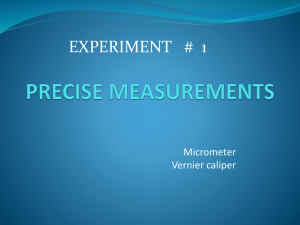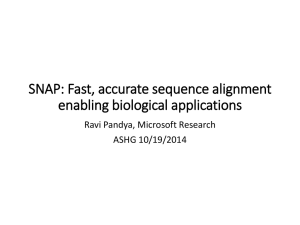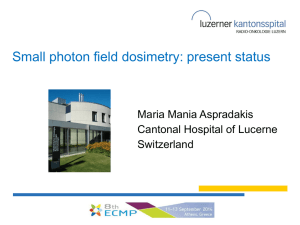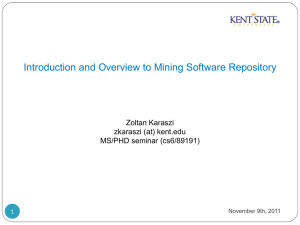neaupg-rlpd2
advertisement
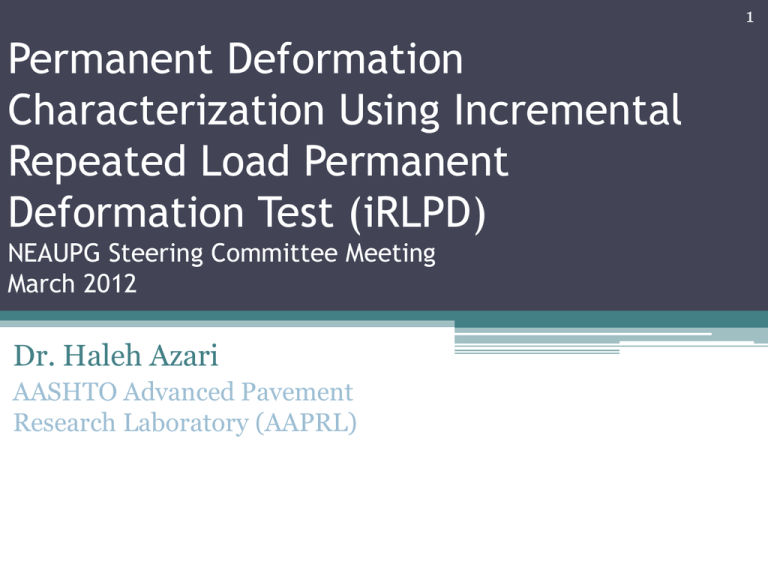
1 Permanent Deformation Characterization Using Incremental Repeated Load Permanent Deformation Test (iRLPD) NEAUPG Steering Committee Meeting March 2012 Dr. Haleh Azari AASHTO Advanced Pavement Research Laboratory (AAPRL) RLPD Test Protocol Background • A flow number test protocol was developed during NCHRP 9-19, which was later, refined during NCHRP 9-29 (AASHTO TP 79) • Several parameters were left undetermined and not standardized • FHWA ETG has created a task force to ▫ standardize the variables of the test such as test temperature, stress level, confinement ▫ Establish criteria that can reliably discriminate between various mixtures Selection of Promising RLPD Protocols Different agencies have offered different approaches in standardizing the flow number test Six promising approaches were selected by the ETG Flow Number Task Force for further evaluation Selected methods are proposed by AAT (NCHRP 9-33), NCAT, Van Quintus (NCHRP 9-30A), MTE, AAPRL, UNR Nine different mixtures representing a wide range of traffic and climate were provided by the state DOTs and industries for the evaluation AAPRL is testing the nine materials according to five of the proposed methods UNR is testing the materials according to UNR proposed method List of Materials and Suppliers Mix. Mixture Traffic Binder Grade Mixture NMAS, mm 1 WI (E3) <3 PG 58-28 12.5 2 NC PG 64-22 9.5 3 TX PG 70-22 9.5 Dale Rand - TXDOT 62.7 4 WI (E10) PG 64-28 12.5 Erv Dukatz –Mathy Const. 46.7 5 IN PG 64-22 9.5 Huber 53.3 6 FL PG 67-22 9.5 7 NJ PG 76-22 12.5 8 AL (NCAT track sec. PG 67-22 9.5 Randy West 59.5 9 CA PG 70-10 19.0 Adam Hand 62.5 # <10 >30 Supplier LTPPBind High Temperature, 50% Reliability, °C Erv Dukatz – MTE Const. Todd Whittington NC DOT Jim Musselman FLDOT Tom Bennert NJDOT 49.1 58.6 63.0 50.2 5 Description of Test Protocols • NCHRP9-30A, MTE, NCAT, NCHRP9-33 approaches are according to conventional flow no. test: ▫ Test continuous until either material goes to flow, 10,000 cycles is completed, or 50,000 microstrain of total permanent deformation is reached ▫ Tests are conducted on 3 replicates at one temperature and one stress level ▫ MTE method is conducted on 9 replicates at 1 temperature and three stress levels (each three replicates tested at one stress level) • AAPRL method (iRLPD) uses 3 replicates; each specimen is tested incrementally at different stress levels Stresses and Temperatures Methods NCHRP 9-33 NCAT NCHRP 9-30A MTE AAPRL (iRLPD) Confinement, kPa (psi) 0 69 (10 ) 69 (10) 69 (10) 69 (10) 600 (87) 482.6 (70) 482.6 (70) 400, 600, 800 (58, 87, 116) 400, 600, 800 (58, 87, 116) Deviatoric Stress, kPa (psi) Temperature, °C* Mix. # Material 1 WI (E3) 49.1 43.1 29.9 49.1 49.1 2 NC 58.6 52.6 35.5 58.6 58.6 3 TX 62.7 56.7 36.0 62.7 62.7 4 WI (E10) 46.7 40.7 29.0 46.7 46.7 5 IN 53.3 47.3 33.0 53.3 53.3 6 FL 63.0 57.0 34.3 63.0 63.0 7 NJ 50.2 44.2 32.0 50.2 50.2 8 AL 59.5 53.5 35.5 59.5 59.5 9 CA 62.5 56.5 35.5 62.5 62.5 *Temperatures are selected based on 50 % reliability high pavement temperature from LTPPBind at depth of 20 mm 7 Description of Incremental RLPD (iRLPD) Test • iRLPD test is conducted at one temperature (LTPPBind High Temperature, 50% Reliability) in four increments ▫ 1000 cycles at 100 kPa (to ensure primary stage of deformation is completed and mixture is in the secondary stage of deformation) ▫ 500 cycles at 400 kPa ▫ 500 cycles at 600 kPa ▫ 500 cycles at 800 kPa ▫ Total of 2500 cycles takes 43 min. • iRLPD method uses strain rate at the end of each increment (minimum strain rate=MSR) as the measure of resistance of a mixture to permanent deformation Output of Conventional Flow No. Test RLPD Parameters Primary Tertiary Flow Number Minimum Strain rate Secondary Strain rate consistent No. of Cycles • Graphs of strain and strain rate versus number of cycles • Consist of three portions : Primary, secondary, and tertiary 9 Example of iRLPD Test, Increasing Temperature Permanent Strain per Cycle 200 180 Strain rate (micro strain per cycle) 160 140 120 T=50 100 T=55 80 T=60 T=65 60 T=70 40 20 0 0 200 400 600 800 Cycle 1000 1200 1400 1 24 47 70 93 116 139 162 185 7 30 53 76 99 21 44 67 90 12 35 58 81 3 26 49 72 95 17 40 63 86 109 132 155 178 Strain Rate, Microstrain/cycle 10 Example of iRLPD Test, Increasing Stress Permanent Strain Per Cycle 400 350 300 250 200 150 100 50 0 Cycle 11 MSR vs. Temperature and Stress • For combinations of stress and temperature the same MSR values were observed • It was found out that effect of temperature and stress are interchangeable • Parameter TP, which is the product of temperature and stress is then used to explain MSR 12 Create MSR Master Curve • Plot MSR as a Function of Temperature * Pressure (TP) MSR master curve • MSR master curve defines the response of a mixture at any temperature and stress 13 MSR Threshold Values Criteria for selecting stress and temperature was based on achieving MSR values in the range of 1 to 30 microstrain/cycle: A combination of temperature and stress that results in MSR of less than 1 microstrain/cycle indicates that the mixture has the potential to stand much higher temperature and stresses A combination of temperature and stress that results in MSR value higher than 30 microstrain/cycle indicates that the mixture is reaching its limit in resisting flow 14 MSR Threshold Values ▫ A combination of temperature and stress that results in MSR of less than 1 microstrain/cycle indicates that the mixture has the potential to stand much higher temperature and stresses ▫ A combination of temperature and stress that results in MSR value higher than 30 microstrain/cycle indicates that the mixture is reaching its limit in resisting flow ▫ Selected the stress levels to obtain MSR values greater than 1 μstrain/cycle and smaller than 30 μstrain/cycle MSR Curves for WI (E3), WI(E10), NC, IN MSR Master Curves for AL,TX, FL, CA 17 MSR Values from iRLPD and Flow No. Tests WI(E10), WI(E3), FL, CA 18 MSR Values from iRLPD and Flow No. IN, NC, TX,AL 19 Ranking of Mixtures based on MSR Master curve 20 Field Applications, Estimate Rut Depth • Use traffic and pavement temperature data to determine TP (temperature * pressure) • Obtain MSR from the master curve for the determined TP • Multiply MSR (strain /cycle) by traffic ESAL to obtain total strain • Multiply strain by pavement thickness to estimate rut depth 21 Example , Estimate Rut depth MSR= a eb*TP Thick Years Months Hours Wander Aging Ratio 75 20 4 (ratio 0.33) 8 (ratio 0.33) 0.5 0.5 Material 1 Material 2 Material 3 Material 4 Material 5 a 0.0979 0.0428 0.0994 0.1965 0.2181 b High Pavement Temperature 0.1169 0.1178 0.0946 0.0834 0.0584 46.7 58.6 62.7 53.3 63 Pressure (MPa) 0.6 0.6 0.6 0.6 0.6 Axles, millions 10 3 3 10 10 MSR, μstrain/cycle 2.6 2.7 3.5 2.8 2.0 micron/axle 0.194 0.202 0.262 0.212 0.149 Axles 1st Year 27778 8333 8333 27778 27778 Rut 1st yr, mm 5.4 1.7 2.2 5.9 4.1 Rut 20 years, mm 10.8 3.4 4.4 11.8 8.3 22 Field Applications, Determine Traffic Level from MSR ▫ Use traffic and temperature data to determine TP (temperature * pressure) ▫ Obtain MSR from the master curve for the determined TP ▫ Multiply MSR (strain /cycle) by layer thickness to obtain permanent deformation/cycle ▫ Divide maximum allowable rut depth by deformation/cycle to obtain the allowable no. of passes (ESALS) 23 Example, Determine Traffic Level from MSR Thick Years Months Hours Wander Aging Ratio 75 20 4 (ratio 0.33) 8 (ratio 0.33) 0.5 0.5 Material 1 Material 2 Material 3 Material 4 MSR 35.22 10.57 3.52 2.11 Terminal Rut 12.7 12.7 12.7 12.7 micron/axle 2.64 0.79 0.26 0.16 Rut 1st yr 6.35 6.35 6.35 6.35 Axles 1st Year 2,404 8,013 24,038 40,064 With Wander 4,808 16,026 48,077 80,128 Allowable Axles, 20 yrs 865,385 2,884,615 8,653,846 14,423,077 24 Field Applications, Determine Acceptable MSR Value for A Design Traffic Level ▫ Divide allowable rut depth by Design ESAL to calculate allowable permanent deformation per axel ▫ Divide allowable permanent deformation by design thickness to obtain strain per axel or MSR 25 Determine Acceptable MSR Values for Ranges of Design Traffic Levels Thick Years Months Hours Wander Aging Ratio 75 20 4 (ratio 0.33) 8 (ratio 0.33) 0.5 0.5 Axles 1,000,000 3,000,000 10,000,000 30,000,000 50,000,000 Terminal Rut 12.5 12.5 12.5 12.5 12.5 Rut 1st yr 6.25 6.25 6.25 6.25 6.25 Axles 5,556 16,667 55,556 166,667 277,778 Axles w/ wander 2,778 8,333 27,778 83,333 138,889 micron/axle 2.25 0.75 0.23 0.08 0.05 MSR 30.00 10.00 3.00 1.00 0.60 26 Table 1-Ranges of MSR values for various Traffic levels Axels MSR, strain/cycle <3,000,000 >10 & <30 3,000,000 to 10,000,000 >3 & <10 10,000,000 to 30,000,000 >50,000,000 >1 & < 3 <1 27 Laboratory Application: Ranking of Mixtures Two ways of ranking/ grading mixtures in laboratory (for a fixed stress and pavement temperature and no consideration of design ESALS): ▫ For a particular TP value, e.g., 36 (0.6 MPa * 60°C), the lower the MSR, the more resistance to rutting ▫ For a particular MSR value, e.g., 25, the higher the TP, the more resistance to rutting 28 Laboratory Application: Mixture Selection • If for a determined TP, MSR value of a mixture is less than the values provided in Table 1, the mixture meets the criteria for high temperature performance • Determine TP using: ▫ 50 % reliability high pavement temperature from LTPPBind at depth of 20 mm ▫ Average tire pressure of 600 kPa (90 psi) 29 Selection of Mixtures, Example • High pavement temperature for Region 1 from LTPPBind= 62.7C • Use stress of 600 kPa (0.6 Mpa) • TP= 62.7 * 0.6= 37.6 MPa°C • MSR from master curve= 12.5 (> 10 & <30) • Mixture is acceptable for design traffic of less 3 million (see Table 1) 30 Summary, Comparison of iRLPD with Conventional Flow Test • MSR values from conventional flow number test coincided with the MSR master curve produced from iRLPD test • iRLPD test using 3 replicates provides the same MSR values as conventional flow number test using 9 replicates • While conventional flow number test produces one MSR value, iRLPD test produces a sweep of MSR values for creating MSR master curve 31 Summary, Comparison Cont. • Using incremental RLPD, testing time is reduced by a factor of 4 • Test takes less than 45 min for each replicate • Complete high temperature characterization of a mixture in 2 hr. and 15 min (3 replicates) • Minimum strain rate values have much smaller variability than flow no. or total permanent strain (average CV of 7 % vs. 13%) • MSR values from MSR master curve are directly applied to the field without use of transfer functions 32 Summary of Differences between Conventional Flow No. and iRLPD Tests Test Parameters Incremental RLPD Conventional Flow No. Test Test property Minimum Strain Rate (MSR) Number of Cycles to Flow, minimum strain rate (MSR), total permanent strain No. of cycles 1000, 500, 500, 500 variable Test temperature 50 % reliability high pavement temperature from LTPPBind at depth of 20 mm Not defined Stress level Four stress levels: 100, 400, 600, 800 kPa Not defined Test duration Less than 45 minutes Test output produces a sweep of MSR values for creating MSR master curve Test Variability MSR has small variability Both flow no and total permanent strain are highly variable Field application Test results can be directly applied to the field without transfer function Flow number has not been directly applied to the field Laboratory application Test results are applied for mixture selection and mixture grading No mixture selection/mixture ranking methodology exists based on flow no. test results (15, 58, 87, 116 psi) Variable- few minutes to 3 hrs depending on temperature, stress level, and resistance of the material produces one MSR, one flow number, one total permanent strain 33 Summary, Laboratory Application of MSR Master Curve • Mixture selection: ▫ For a particular TP (pavement temperature * average pressure) and design traffic level, a mixture with MSR values within the ranges provided in Table 1 is acceptable in terms of high temperature performance • Ranking/grading of various mixtures: ▫ For a fixed TP, a mixture with lower MSR is more resistant to permanent deformation ▫ For a fixed MSR, a mixture with higher TP is more resistant to permanent deformation 34 Summary, Field Application of MSR Master Curve • MSR (strain per cycle) from MSR master curve can be used to estimate : ▫ Allowable traffic ESALs ▫ Total rut depth • The design traffic ESAL can be used to calculate acceptable MSR (Table 1) 35 Recommendations: Evaluate the applicability of Incremental RLPD for WMA, and high percentage RAP, and combination of both Investigate Incremental RLPD test method for different confinement stresses Thank you. Questions?
